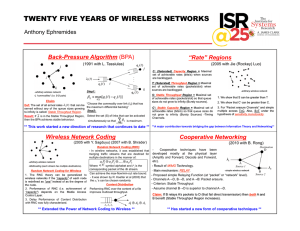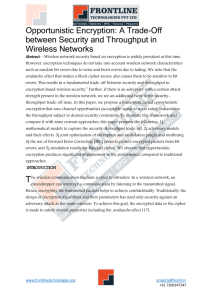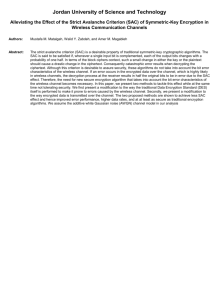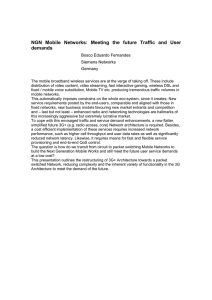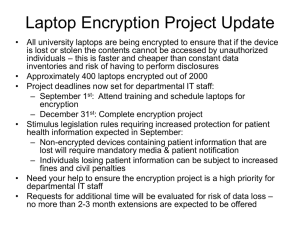17.1 Inline Network Encryption for Multimedia Wireless LANS
advertisement
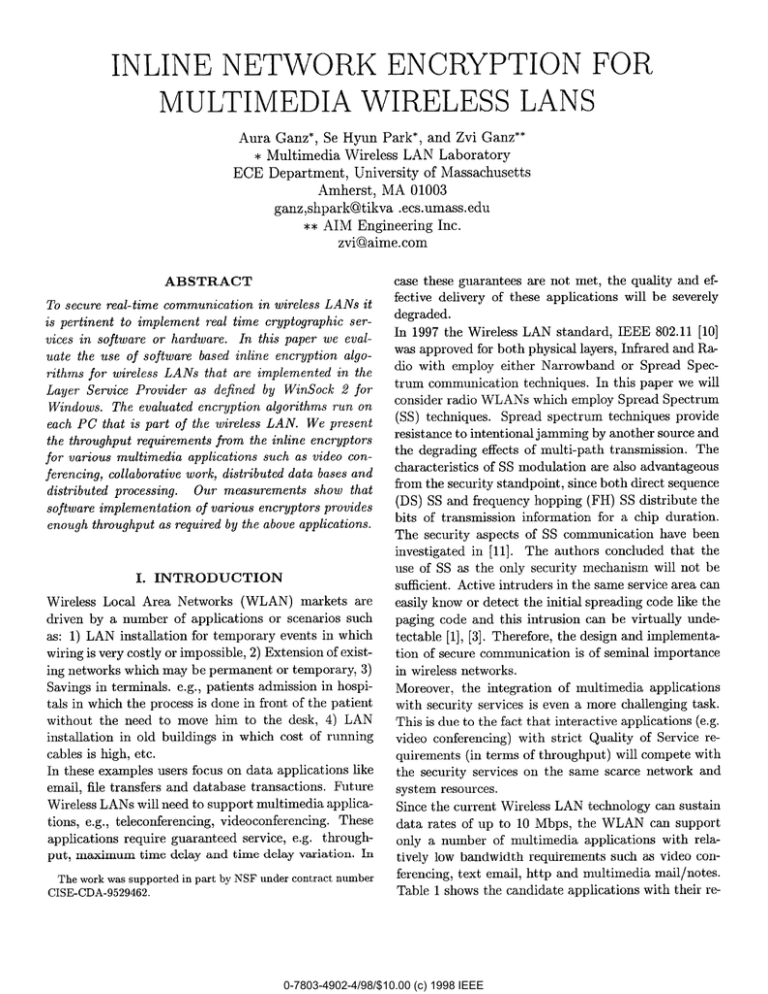
INLINE NETWORK ENCRYPTION FOR MULTIMEDIA WIRELESS LANS Aura Ganz*, Se Hyun x Multimedia ECE Park*, Wireless Department, and LAN University Amherst, xx AIM Ganz** of Massachusetts MA ganz,shpark@Nikva Zvi Laboratory 01003 .ecs.umass.edu Engineering Inc. zviQaime.com case these ABSTRACT To secure real-time is pertinent vices in uate to implement soflware for Layer Service wireless Windows. real that various LANs distributed software encryption processing. throughput from work, ser- algo- LAN. run on We present the inhne such of various the 2 for algorithms as video data con- bases and show encryptors fective delivery that provides by the above applications. of these In 1997 the Wireless was approved dio with trum employ Wireless Local driven as: by communication consider (SS) radio is very costly Savings without need the installation In these process to Wireless buildings the e.g., users will and of exist- or temporary, admission in front to 3) in hospi- of the patient the in which focus require on data database desk, cost effects characteristics 4) LAN applications the security (DS) SS and frequency multimedia like applica- videoconferencing. of transmission The security aspects [11]. know paging guaranteed service, e.g. of secure through- the This the conferencing) and time delay variation, for system services provide source authors security direct sequence a chip have concluded mechanism the initial spreading intrusion the duration. will not of multimedia a more interactive strict code like the same unde- importance applications challenging task. applications (e.g. Quality of throughput) be and implementa- ion is of seminal is even the area can can be virtually the design been that in the same service on the and The SS distribute of SS communication with (in terms security will scarce of Service compete network rewith and resources. data rates only a number Table delay information is due to the fact that we will Spectrum are also advantageous since both integration services Spec- transmission. (,FH) communicant Moreover, The work was supported in part by NSF under contract number CISE-CDA-9529462. time this networks. tively maximum and paper by another hopping The [10] and Ra- techniques jamming [1], [3]. Therefore, in wireless In put, or detect code tectable tion only 802.11 Spread of multi-pakh Act ive intruders Since the current These ef- be severely Spread In this spectrum standpoint, bits video Future and Infrared or employ of SS modulation flom easily which to intentional wit h security of running transactions. need to support teleconferencing, applications 2) Extension IEEE layers, techniques. Spread degrading quirements transfers LANs him such in which etc. examples file move are events patients is done markets or scenarios temporary be permanent e.g., in old is high, email, may in terminals. the cables for or impossible, which tals in which tions, of applications installation ing networks ( WLAN) quality standard, Narrowband WLANS techniques. sufficient. Networks a number 1) LAN wiring Area the will physical either use of SS as the INTRODUCTION met, applications LAN for both investigate ed in I. are not degraded. resist ante encryptors measurements as required in WinSock distributed Our implementation enough by it we eval- are implemented applications collaborative paper encryption of the wireless multimedia ferencing, this as defined requirements LANs cryptographic In that evaluated is part the throughput time based inline Provider The each PC in wireless or hardware. the use of soflware rithms for communication guarantees low ferencing, Wireless of up LAN to 10 Mbps, technology the of multimedia requirements text ht tp and email, the candidate 0-7803-4902-4/98/$10.00 (c) 1998 IEEE can support applications bandwidth 1 shows WLAN can sustain such multimedia applications with as video relacon- mail/notes. with their re- quired throughput. Inline security ofApplications Types plemented service either in crypts/decrypts in ted/received tions is defined hardware network of NSA’S crypt ographic boxes communication high by a number MISSI security these multimedia [6]. in a very WLANS due low used in portable mostly In this paper inline encryptors to the data rates, may not WLANS devices, Table characteristics: and low LAN, run 3) implemental ion disadvantage the computer and is that system implementation based It is important flexible upgrades. by impedes the the throughput Wireless and different each using service provider, are forwarded we can aware of us● penalties encountered by other communication use any the to the the packets are intercepted using by the CryptoAPIs application. has the ● Of off-the-shelf do not need oft he fact that that following advan- applications, Ibe modified to suitable tion and network to choose made techniques. interface a network encryption the card, interface capability either or software easy upgrade course need i.e., we use encryption incorporates in hardware in protocol by provided, is sent down are decrypted architecture we do not card by a packet is generated and we can use any off-the-shelf i.e., this deter- We also con- 1). At the destination to the be- tages: for two computer loads. resides IIayer service application in and the lower-level that CryptoAPIs layer functions [7] that 2 DLL at the protocol. proposed Provider packet algorithms service (see Figure is intercepted to this ● we have implemented is obtained source, encryption crypto Service belong The as WinSock that of a number delay of the encryption the proposed for very high speed may hinder throughput algorithms implement at ion networks the may since use of the not be the encryphigh speed channel. layers. measurements of various show encryptors by the above paper the algorithms and their performance the conclusions implementation enough III. throughput In the software next section architecture. The Encryption In this subsection in software perimental is depicted III. (B...), software are provided analysis based necessary inline in Section Section IV. encryptors. for Throughput Experimental Re- sults we have implemented in Section EXPERIMENTS as A. as follows. the performance proper software applications. proposed encryption also provides that provides is organized we describe choosing for Multimedia software provider is encrypted encryption To make caused The the by the ap- in the system III At and is limited is determined which throughput 2 Layered the principal applications sider additional The [4] base transport and hard- the suitability requirements. configurations than intensive encryptors algorithms The is part above for which that we have measured of encryption our CryptoAPI base transport key cryptography. to understand throughput required [ IMPLEMENTATION implemented using application encryptors listed configuration as public software inline its performance of computational such that it is cheaper more based 2 for Windows. characteristics ware Our Applications SOFTWARE WinSock in the Layer on each PC Software for WLANS The system MPEG video Candidate II. We cost, 4) a distributed by WinSock advantages: software. 1. be the best are implemented has the additional mination 64kbps FI lZ8kbps - lMbps I 1.54Mbps LANs shared the use of software which algorithms wireless are suitable plication ( tween as defined evaluated ing inline audio high-speed of Mbps). 2) relatively we investigate Provider algorithms Applicafiom videa con ferenctig environment. of the < 103kbps notes Multimedia telephone-quality These are usually hardware 1) relatively Service Interactive TACLANE hundreds boxes applica- the very high and family) or en- transmit- of computers. choice The (tens cost, cryptography mobile into are a necessity Dedicated for FASTLANE network to their plugged e.g., I ~a im- that packet Some military boxes lines, software every by the application. (members Due or real-time use cryptography speed as a mechanism, we provide results, we have in terms obtained a description of encryption for a number of the ex- throughput of encryption algorithms. To obtain the encryption computer configurate 0-7803-4902-4/98/$10.00 (c) 1998 IEEE ions: throughput we have used two 1) configuration M 1: Pen- Throughpu, I hkasumd Bulk Etw@on Al@?rifhms I Ml M2 11 Memory B AwihUe Resources I I I .%mdzwdWimock 2.0 DLL I .+kd”k r---”---------------i---------------------! : Enc. 1 3il Dec f 4N RG! Enc Dec \ 3.6 I 3.5 RSA Enc. Da , 8,6 RC2 ! ............ CPU ~% ,h_,, — Table I 161 Ml : Pentium MMX 166MHz, 16M Main Memory, 512U L2 Cache,Window 95 M2 : Pentium Pro 2CQMHZ,32M Main Memory, 256K Ir,temal L2 Gcha, Windows NT Enc : Encryption 2. Bulk Dec Encryption : Decryption Algorithms Measured Through- put i Wi?zhs, Network M.+. Cad timedia Figure 1. Software Inline (ISLSP) Architecture Secure Layered Service Provider 1) the put, applications. wireless 166MHz, and Windows 95), Pro 200MHz, 32M cache and We 16M main and have encryption RC2 (block in cipher), and We have also integrated other symmetric in the and RSA processed per second. from main These encryption From tools 2 we observe encryption the encryption In en- use the same key. much slower algorithms the number main of throughput almost and decryption such as RSA petition on WLAN. Therefore, Multimedia Wireless this based subsection inline for WLANS we process ● In is in ● for time support effective (bps), i.e., and com- nodes in bandwidth the WLAN data the can be rate. by the application (bps). at the source(bps) mul- overhead time a packet ical layer, and transport TDOH at in all data the destination layer, layer). This delay protocol the time overhead spent time and layers driver, to (physnetwork also includes any layers. by a packet includes its at the required :protocol in these This time clevice delays a packet the time queueing at the required delay all the layers. Bs the maximum source rate at which interface a packet rate to the ways a packet 0-7803-4902-4/98/$10.00 (c) 1998 IEEE bandwidth the source card, available 9 BD the maximum data by a packet the the link to process imum spent includes destination. protocol use of software that en- by other noise other throughput This maximum the from this less than the source. queueing LANs we investigate encryption Encryption incurred channel channel decryption w TSOH ways Inline the encryption network of Software and section), bandwidth the throughput in throughput. Suitability effective account requested throughput algorithms. into B.n. on output the bottleneck LAN we take B.PP bandwidth for each bulk identical size (bits) ● of 95/NT, configuration notations: ● Ml determinants of Windows packet BW wireless in resources 2. Based of that (bps) reported Available the following ● 9 .B&C of bytes configurations in terms in the previous overhead with D data encryption as through- throughput computer (as shown processing significantly than consideration such layers. ● key algorithm measurements for Table the range key algorithms algorithms protocol algorithm. of symmetric B. both as the are the management Table public that encryption loads. memory have determined CryptoAPI: are imply for two computer the experiments system of which We measured and M2 as well as different and number cipher) data is defined 2 were taken a [5] public above layer. which CPU and 4) additional L2 . the throughput choosing Pent ium internal by operations decrypts all application Table (stream algorithms tested ISLSP which decryption encrypts M2: 256K provided RC4 crypt ion have our algorithms which cryption We proceed algorithms symmetric-key L2 cache ion memory, into QoS requirements by the 512K NT. integrated bulk We 2) configurate main Windows memory, take 3) encryption/decrylption is determined MMX will characteristics 2) the applications’ throughput, tium We LAN assuming at which available that to be sent from destination application, (bps), the the max- PC sends data bandwidth destination assuming that to the there is al- the source. (bps), the PC sends there is al- to be sent to the destination Distance Source I , Wireless Channel De4ination I :Ik!=l:l:a Wrm” TCPI’JP I ‘c ‘“ DIBw II ‘ttqE,...i.. I NIC : Netwmk Grd [nterke D.1.. : h Zone for 2. from Application-to-Application the (A) . the decryption delay (&) To 2 depicts using sustain the Packet end-to-end with bandwidth packet size D, mzn(Bs, now widths, compute BD the 13s and BD, We compute the and destination in all source PC. required by an there spent Since one layer and that layers and a packet DD destination band- of the protocols’ at the source CPU (worst (1) over- throughput. by a packet algorithms is always application at the source and at the des- handles the including In this case we can assuming case computation) loads, from BdeC (2) and equations = z&” deci- software encryption with TSOH use this inline software encryptor (Fig- For example: for a videoconferencing wireless bandwidth LAN = 510psec, the inline TSOH of lMbps, D = 64Bytes, and throughput l?enc encr~yptor 256 Mbps. Equation bandwidth, session of 2 Mbps, (6) and asssuming (7) the maximum BW > B.PP, application is given by: B~pz the (2) (3) example: of 4 Mbps, 64Bytes, sustain (3) we obtain: &_+ following Bapp, and (4) > B.PP value for an inline wireless and TSoH applications For given Bs the we obtain: + TDOH 1 with ure 3). For DD —=— BD up the use of inline If B ~nc ~ Bg~ Using encryp- high for transmission Given: come Ben.: has to be at least protocols the – — -t TSOH – BenC ~ Using Encryptor (7) sion regarding app and decryption communication tion/decryption i.e., 2 as a function time we have the Security packet ~~pp we require: , &J) head and of the encryption tination Zone of Inline notations. throughput We 3. Journey application-to-application the above the application En.vptor (6) delay Figure Software network. . the encryption journey Inline Data Liok Figure Figure A, nun ‘-”K, B .. q Encryptiommpt,on Thro.ghpul(lpi) highei @, values of TSOH, the required LAN = encryptor lmsec, the of at most denoted bandwidth of 2 Mbps, inline encryptor D = can 454 Kbps. of Bw, B.pp, B..,, application with bandwidth by TS&ff bandwidth and D, the m=imum that will still is given provide by: emc 1 BD The minimal sustain tem the = 1 , TDOE Bale= ‘ D encryption application parameters is given and decryption bandwidth by (5) > B.pp with throughput the given (9) to Figure sys- values tion 5 show= TS~# as a function of Bapp, and D. Figure of Bent for various 0-7803-4902-4/98/$10.00 (c) 1998 IEEE values of ~enc for various 4 shows of TSOH. B~P& as a fine. We observe: next step timedia is to test the encryption algorithm in a mul- testbed. References [1] S.H. Park, A. Ganz, and Z. Ganz, “Security Protocol for IEEE 802.11 Wireless Local Area Networks,” to appear in ACM Mobile Net works Journal Sp,ecial Issue on Wireless Local Area Networks. [2] A. Ganz, D. Awduche, A. Phonphoem, and J. Euh, I. Kim, Z. Ganz, E. Hasiett, “Multimedia S.H. Park, Wireless LAN Third Telecommunication R(!4D Conference Massachusetts, Lowell, MA, Nov. 1997. Prototype? [3] A. Aziz and W. Diffie, less Local First [4] Quarter, Microsoft, R.L. Interface,” Rivest, A. Cryptography Version Shamir, Digital G .N. Cohen, and Microsoft, L.M. Adleman, Method Cryptosys- of the ACM, v. 21, n. 2, Feb. 1978, Kamenel, Virginia, “Windows Pro- “A and Public-Key and C.M. Kubic, IP-ATM/Tactical-Strategic 96, McLean, [7] B. Application 2.o, 1997. Signatures tems,” Communications pp. 120-126. Integrated for Wke- Communicationsj 1994, pp. 25-31. for Obtaining [6] and Authentication IEEE Personal ‘(CryptoAPI: gramming [5] “Privacy Area Networks,” in (let. “Security 1996, IProceedings, Sockets 2 Service pp. 456-460. Provider Interface,” Revision [8] 2.2.2, Aug. 7, 1997. Security Product J. Banes, “Internet for MILCOM Networks;’ from ie.07 -.06 0..06 7e. c6 !%.06 5..06 ,e+ce a.m Enmyp!,o.lDec,ypl,on BanOw,dlh(+s) 2.+08 ,..G3 [9] o [10] Flgure5. Z’S~& versus B..C for D = 256Bytes Microsoft Intel, ‘(Common Draft Release IEEE Standard H. Imai, increases spent for encryption overhead ● For as B.nC increases. decreases, As the time the remaining Proceedings ASIACRYPT time increases. increased decreases application since bandwidth less time I?.PP, TS~& can be spent on the com- puter. IV. In this based paper inline encryption throughput for different software two loads. based cations, inline per packet data In cooperation Wireless sachusetts WLANS We have computer To at that use of software integrated and encryption a number measured systems determine their configurate the the multimedia of appli- application size, the time protocols ions suitability for multimedia the packet for communication the WLAN the algorithms we have considered request ed bandwidth, media investigated encryptors. of popular and SUMMARY we have overhead processing, and rate. with LAN Amherst surmort . . AIM Engineering Laboratory at University is developing multimedia Inc., the Multiof Mas- a prototype abdications . . 802.11 “Information Systems,” TS&?f Data 1.2, Mar. Version Security Unit ,“ Internet 0.7, Nov. Architecture Draft 1996. Specification,” 1997. for Wireless LAN, IEEE P802. 11, 1997. [11] ● Corporation, for .121. . Our 0-7803-4902-4/98/$10.00 (c) 1998 IEEE Security Aspects of the Advances ’94, 1994, pp. 195-208. of Spread in Spectrum Cryptography -
